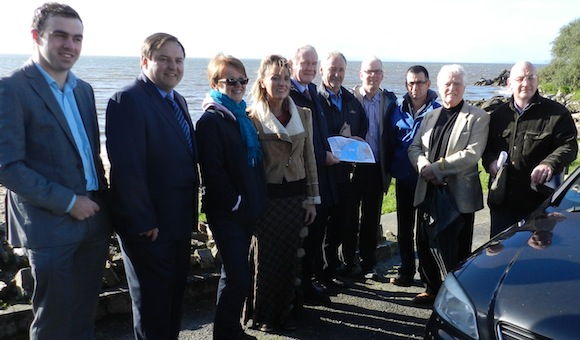
Left to Right: Councillor Jack Murray Deputy Padraig McLaughlin Dr Bernie Lafferty MEP Martina Anderson Deputy First Minister Mr Martin McGuinness Enda Craig (CFCE) Dr Don McGinley Thomas Farren (CFCE) Dan McGuinness (CFCE) Mr Terry Crossan (Loughs Agency)
THE North’s Deputy First Minister Martin McGuinness and northern MEP Martina Anderson have thrown their weight behind the campaign to stop a sewage water treatment pipe pumping into Lough Foyle.
The Campaign for a Clean Estuary has been arguing for a treatment station to be located outside Lough Foyle.
And at the weekend Mr McGuinness visited the area where sewage will be pumped; and although it will be treated, it also provides for untreated sewage to be pumped out
Here spokesman Enda Craig gives his views on a 23-year battle with Donegal County Council and raises two of the main points.
By Enda Craig
1) The negotiations between representatives of the UK and Republic of Ireland over the longstanding question of jurisdiction over the seabed of Lough Foyle.
This raises for us, as an environmental group, the question of the potential future consequences of a negotiated settlement of the boundary dispute. If any boundary is agreed along Lough Foyle, which will grant uncontested jurisdiction to the Republic side of the boundary, our fear is that this will bestow on our local and national authorities, the right to use Lough Foyle for discharge of pollutants into the estuary. The outfall pipe from the WWTP, part of an illogical conceptual overall proposal, is a clear example of this. The Donegal County Council have striven against us over the last 23 years and against all reasoned argument, to achieve just that. A Compulsory Purchase Order has actually been raised for the compulsory acquisition of the part of the seabed required for this pipeline. This was issued to the Minister for the Department of Agriculture, Fisheries and Marine who are listed under the CPO schedules as the owners or reputed owners of the foreshore. No such ownership exists and this is a false claim. While we would greatly appreciate a happy solution to this long dispute, we can only foresee the ultimate destruction of the biodiversity of Lough Foyle in any solution that would give the right to damage further a waterway that we all share and is precious to all of us on all sides of the dispute. We are of the firm belief that the Foyle can be brought back to its original full biodiversity for the benefit of all communities that use it. It is for this reason that we appeal strongly for firm pressure be exerted during these negotiations to ensure that protective clauses are introduced which recognize this goal and prevent polluting industries that have reasonable access to open water, discharging into the Foyle for any reason whatsoever. We particularly emphasize a complete ban on any attempt to pump untreated effluent upstream and away from open water for the very purpose of treatment and discharge into our tidal estuary.
2) The classification of the Foyle estuary as coastal waters.
Any reasonable observer would find the greatest difficulty in viewing Lough Foyle as coastal waters; yet this is what was done in cooperation between the Republic of Ireland EPA and the Northern Ireland NIES some years ago, on foot of the arrival of the Urban Wastewater Treatment Directive in 1990. This took place without any consultation with affected parties. Subsequently in 2005, the Water Framework Directive, the definitive directive on waterways, came into play. The 1990 reclassification was then simply accepted as the defining legal classification of Lough Foyle as coastal waters without, apparently, any further examination. [Some additional research revealed that the UK government lost their case in the EU Court of Justice defending a similar case in the Severn estuary. Other UK estuaries, which were included in this blanket reclassification, face similar redress.]
In the case of the Foyle estuary, this classification is an outrageous affront to reason and common sense, let alone the geological sciences, yet the technical people involved, who certainly knew better, let it happen. Our interaction with the technical groups on both sides ended with the assertion that a new opportunity for reclassification would arise in 2013 and we intend to raise the question again in the immediate future to ensure Lough Foyle is properly classified.
This again is an issue that seriously challenges the enormous value and biodiversity of Lough Foyle and its’ certain demise if it is allowed to be treated as coastal waters. It is worth emphasizing that the native oyster, which is practically extinct in Ireland, thrived in the estuary. This delicate species cannot survive in coastal water environments. It requires the special environment found in tidal estuaries and the limited ranges of temperature and salinity these estuaries provide. A free or slack hand with pollutants will eventually destroy this species. In Lough Foyle it is already under threat.
For these reasons we took great heart from the immediate response of DFM McGuinness that the classification of Lough Foyle as coastal waters was patently unacceptable and welcomed his promise to look into the matter. We appeal to all sides of our shared waters to look to a new era of recovery of the estuary to a clean and healthy environment we can all enjoy. We hope that unanimity of those with the power to influence this, will ensure that the classification of Lough Foyle is put right. We welcome both the DFM’s strong expression of concern and your own expressed will to follow up with us.







